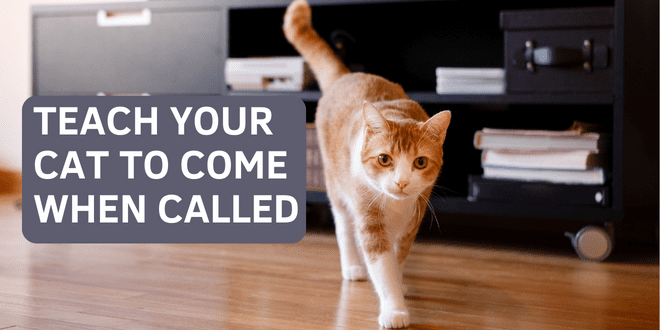
Training to come when called is something most people associate with dogs and not cats. Training cats to respond to a verbal recall cue is very valuable, especially for those who allow their cats access to the outdoors.
Many people are under the assumption that cats aren’t easily trainable, but just shake a bag of treats or open a can of cat food and you’ll appreciate their ability to quickly learn.
Training is easy, and there are certain skills you should take the time to develop as they will strengthen the bond you share with your cat, and create consistency in encouraging desirable behavior. Training, in general, is fundamental for safety reasons, and coming when called is a basic skill that could potentially save your cat’s life.
Here are some general guidelines for starting the training process.
Establish a clear verbal cue. Select a distinct cue and be consistent in using it so your cat will always know what you’re asking of him. For the cue, the most practical one is to include your cat’s name followed by “come” or “come here.” If you only have one cat, you may simply decide on “here, kitty” or some other phrase. Whatever cue you select, be consistent.
Provide tasty rewards. Be supplied with treats that you know in advance your cat enjoys. Have the treats with you as you stand or sit close to your cat. Say the cue and then shake the container of treats to get your cat’s attention. Offer your cat a reward. During the initial stage of training, don’t worry if your cat doesn’t respond by coming over to you – just focus primarily on the cue and the reward. What you’re doing is teaching the cat to associate the verbal cue with the yummy treat.
Don’t overindulge. Avoid filling your cat up with too many treats so keep sessions short. If the treats you use are large, break them in half so you get more mileage out of them. Even a partial treat will suffice in creating a positive association.
Gradually increase the distance. In the beginning be in close proximity to your cat. Progress to being able to increase the distance but initially stay within your cat’s visual range. When he is consistent in coming when called while in the same room with you, work toward calling him when you’re out of sight.
Training schedule. Do the training sessions at random times each day and always reward with a treat. Don’t just train for a few days and expect your cat to have mastered the skill. Use the recall cue during mealtime as well. If your cat tends to run in the kitchen the moment he hears his food being prepared, that’s the perfect time to use the recall cue.
Be patient and positive. Always reward your cat for coming when called, even if it takes a few tries before he responds. What’s important is that he’s learning he’ll get a reward for completing the behavior. Maintain a positive demeanor as you train even if progress is slow. Keep in mind he may not be hungry enough, you may be asking too much too soon, or maybe the timing isn’t right for training. Keep it fun, short, and positive.
No negative recall cues. There are a few rules you mustn’t break when training your cat to come when called. Never use the recall cue to get him to come so you can administer medicine or do anything perceived as aversive or unwanted. If you use the recall so you can do something undesirable, the skill will deteriorate because the cat will no longer trust the consequence of performing the behavior.
Ongoing training. If you call your cat to come to you and you realize you don’t have any treats, or if the behavior is so cemented in his brain you feel you don’t need to use food rewards so much, still acknowledge the achievement by rewarding in some way to preserve the reliability. Praise your cat, pet him (if he enjoys that), offer a toy, or acknowledge in some way he’ll appreciate. Even after your cat has fully mastered the recall cue, keep the behavior dependable by using the cue whenever you feed, if you do scheduled meals. Periodically call him at random times during the day as well and follow that with a treat reward.
Safety benefit. If you keep the recall cue reliable, it can be extremely valuable if your indoor cat ever escapes outside, or if you need to call your indoor/outdoor cat to come back to the house, or to return to you should you see something potentially dangerous nearby.
Expand the training. Once you’ve successfully taught your cat this important behavior, consider expanding to other things such as sit, stay, jump, high five, or whatever you feel will be fun or useful. Training, if done positively and with patience, is very rewarding for both you and your feline student.
Training can help deepen the connection between you and your cat. It’s also beneficial to your cat’s mental fitness, physical safety, and overall well-being. Keep in mind that every cat is unique and will learn at a different pace. Be a kind, patient, and loving teacher.
Need More Information?
For more information on cat behavior and training, refer to the best-selling books by Pam Johnson-Bennett. Pam’s books are available at bookstores and online. We’ve included links to Amazon here on our website.



